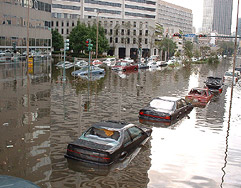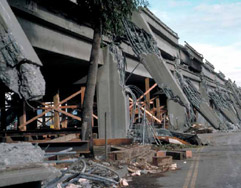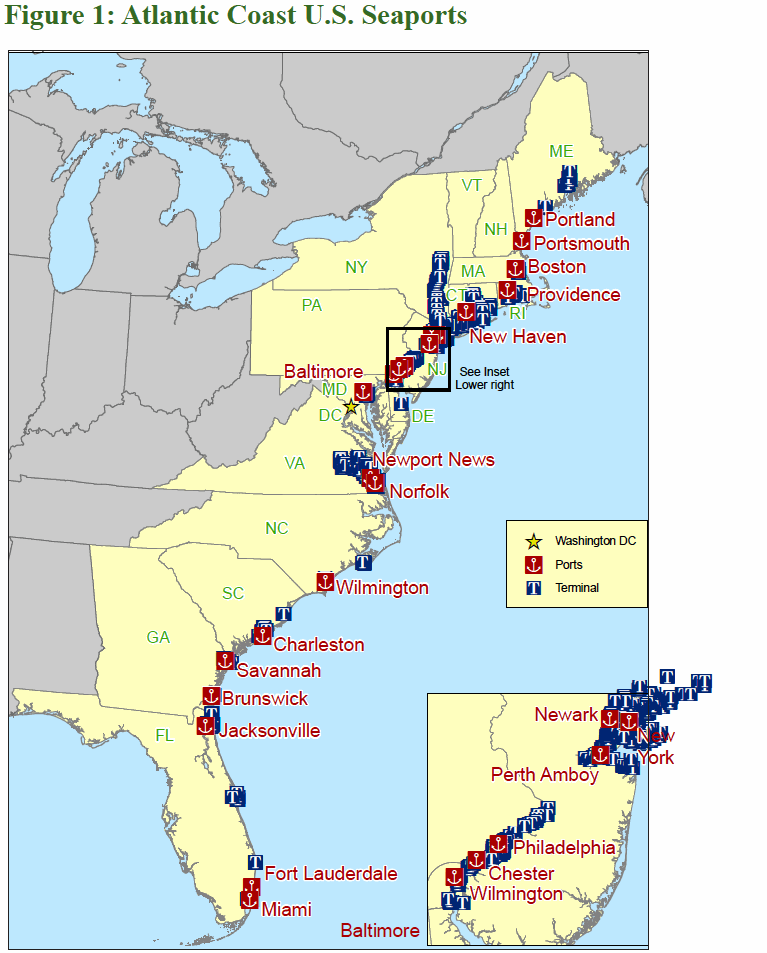RESEARCH AND INNOVATIVE TECHNOLOGY ADMINISTRATION
BUREAU OF TRANSPORTATION STATISTICS
Atlantic coast U.S. seaports from Eastport, ME, through Key West, FL, are preparing for an expected increase in cargo generated by an expansion of the Panama Canal scheduled for completion in 2014 (figure 1). Preparations at east coast ports include installation of larger cranes and dredging channels to accommodate container ships with nearly two and one-half times the capacity of current Panamax vessels, the largest ships that now transit the canal (figure 2).
The Atlantic coast seaports facilitate freight flow and international trade for both the long-established and populous Northeast, and the growing areas along the Southeast Atlantic coast.
This fact sheet highlights the major Atlantic container ports of New York/New Jersey, Virginia, Savannah, and Charleston. Containerships and containerized cargo comprise the bulk of vessel calls and most of the vessel value at these seaports along the eastern seaboard. Commodities transiting the canal to the Atlantic ports include auto parts, bananas, chemicals, canned and frozen fish, and pulpwood, among others.
Select Atlantic Coast U.S. Seaports
Port of New York/New Jersey
The Port of New York/New Jersey was the largest Atlantic coast U.S. seaport in terms of total tonnage and the third largest in terms of intermodal TEU containers handled in 2008. Only the ports of Los Angeles and Long Beach are larger. The public Port Authority of New York and New Jersey, which coexists with privately managed terminals in the area, manages marine terminals (e.g., Brooklyn, Elizabeth, and Newark) and specialized facilities in a 25-mile long port district. These ports handle a wide array of cargo, including break-bulk, container, and Roll On/Roll Off (RO/RO) vessels. However, containerships (52 percent) and tankers (29 percent) account for the majority of vessel calls (table 1).
Port of Savannah
The Port of Savannah, GA, was the second largest Atlantic coast container port and the 22nd largest U.S. port in terms of tonnage handled in 2008. Containership saccounted for over 77 percent of the vessel calls (table 2).
The Georgia Port Authority (GPA) owns and operates the major marine terminals (e.g., Garden City, Colonel’s Island) in the region. The GPA is adding container and gantry cranes.
Port of Virginia
The Port of Virginia includes Norfolk and Newport News, with Norfolk accounting for 96 percent of the value handled. Over 85 percent of the value passing through Norfolk was containerized cargo. Norfolk was the third largest container port along the Atlantic coast in 2008. Norfolk and Newport News were the 16th and 34th largest customs ports in the United States, respectively, in terms of tonnage handled in 2008. Containerships accounted for 65 percent and dry bulk accounted for 22 percent of vessel calls in the Port of Virginia in 2009 (table 3).
The Virginia Port Authority (VPA) owns and operates the major marine terminals (Newport News, Norfolk, and Portsmouth) in the region. In addition, the VPA recently signed a 20-year lease agreement to take charge of a private terminal in Portsmouth, VA.
Download full version (PDF): Atlantic Coast U.S. Seaports
About the Bureau of Transportation Statistics
www.bts.gov
“The BTS mission is to create, manage, and share transportation statistical knowledge with public and private transportation communities and the Nation. The main purpose of BTS’ work is to help advance the DOT Strategic Plan (2006-2011). But we also aim to anticipate future needs and policy issues. Our challenge is to develop data and analyses that are relevant, high quality, timely, comparable, complete, and accessible-our strategic goals for transportation statistics.”
Tags: Atlantic Coast, Cargo, Georgia Port Authority, GPA, Panama Canal, Port Authority of New York and New Jersey, Port of Savannah, Port of Virginia, Research and Innovative Technology Administration, RITA, Trade







 RSS Feed
RSS Feed